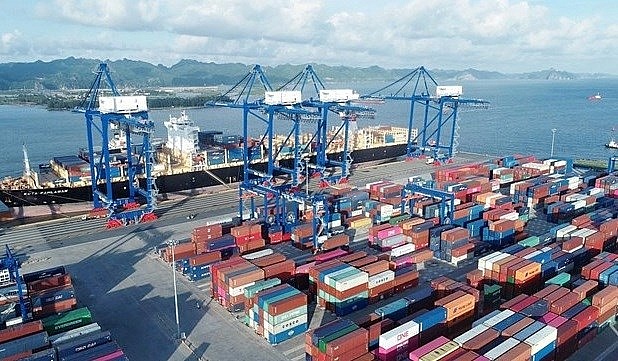Profitable seaports suffer on-year falls
 |
| An aerial view of Haiphong's Lach Huyen Seaport. Photo: VNA |
Vietnam Maritime Corporation (VIMC) reported poor performance at a July 15 meeting on its 6-month results with joint venture seaports with foreign partners, mostly due to unfavourable international developments. VIMC’s total volume of goods and commodities via seaports fell 6.39 per cent on-year to just over 64 million tonnes or 48 per cent of the whole-year target, while its total container throughput suffered an on-year drop of 8.97 per cent to around 2.7 million TEU, or 45 per cent of the whole-year target.
VIMC now has 35 member companies, managing over 13,000 metres of piers and accounting for nearly 30 per cent of the country’s total. These piers are capable of handling over 100 million tonnes of cargo, or one-fifth of the country’s total.
Among the seaports in which VIMC has stakes, some have suffered losses despite the general economy’s improvements. Cai Lan International Container Terminal (CICT) accommodated over 1.87 million tonnes of goods, down 11.74 per cent on-year, while revenues fell 3.36 per cent. One encouraging signal was the facility’s container throughput, which soared over 160 per cent.
Located in the northeastern province of Quang Ninh, CICT is run by VIMC and US-based Carrix, the parent company of SSA Marine.
Similarly, VMIC’s most profitable JV seaport, Cai Mep International Terminal (CMIT), witnessed an on-year fall of 6.72 per cent in its pre-tax profit in the first six months when its container throughput and revenue decreased by about 1 and 3.32 per cent on-year, respectively. The seaport has Denmark’s APM Terminals as a foreign stakeholder.
Le Quang Trung, vice president of VIMC, told VIR, “The major reason for the falls are a decrease in global demand. This possibly comes from the global recession. Other compounding factors such as the continuing conflict in Ukraine, commodity price spikes, and the ripple effect of China’s pandemic policy have also led to the results.”
Meanwhile, SSIT and SP-PSA are also in the same situation. Both are located in the Cai Mep-Thi Vai area of the southern province of Ba Ria-Vung Tau. SSIT, a joint venture between VIMC and SSA Marine, reported poor performance in the total volume of goods and communities, container throughput, and revenues, with respective on-year drops of 13, 18.7, and 11.7 per cent.
Meanwhile, SP-PSA, which VIMC runs with Singaporean-based PSA, witnessed on-year falls of 8.6 and 5.9 per cent in the volume of goods and revenues respectively.
The representative from VIMC explained that the drop in container throughput among seaports in the first half of the year was because of the cancellation of calls between shipping lines because of the Russia-Ukraine conflict, which has negatively affected import-export activities among Vietnamese companies. The representative added the conflict also increased the prices of production materials and oil and petrol, thus leading to a reduction in revenue and pre-tax profit.
In addition, slow economic recovery globally, and a lack of empty containers are the other reason for a fall in container throughput among seaports in Vietnam in general, and those at the Cai Mep seaport area in particular. Worse still, jams at seaports in China due to its pandemic policy has also increased difficulties for the shipping industry.
VIMC forecasts that the situation will continue in the months to come. The shipping market in the second half of this year will largely depend on the Russia-Ukraine conflict, thus challenging the fulfilment of yearly targets among seaports.
What the stars mean:
★ Poor ★ ★ Promising ★★★ Good ★★★★ Very good ★★★★★ Exceptional
Related Contents
Latest News
More News
- Businesses ramp up production as year-end orders surge (December 30, 2025 | 10:05)
- Vietjet chairwoman awarded Labour Hero title (December 29, 2025 | 13:06)
- How to unlock ESG value through green innovation (December 29, 2025 | 10:03)
- AI reshapes media and advertising industry (December 29, 2025 | 08:33)
- FPT and GELEX sign deal to develop blockchain tech for global markets (December 29, 2025 | 08:29)
- Vietnam’s GDP forecast to grow by 9 per cent in 2026 (December 29, 2025 | 08:29)
- Women entrepreneurs are key to Vietnam’s economic growth (December 29, 2025 | 08:00)
- Vietnam's top 500 value-creating enterprises announced (December 27, 2025 | 08:00)
- The PAN Group shaping a better future with ESG strategy (December 26, 2025 | 09:00)
- Masan Consumer officially lists on HSX, marking the next phase of value creation (December 25, 2025 | 13:20)

 Tag:
Tag:





















 Mobile Version
Mobile Version